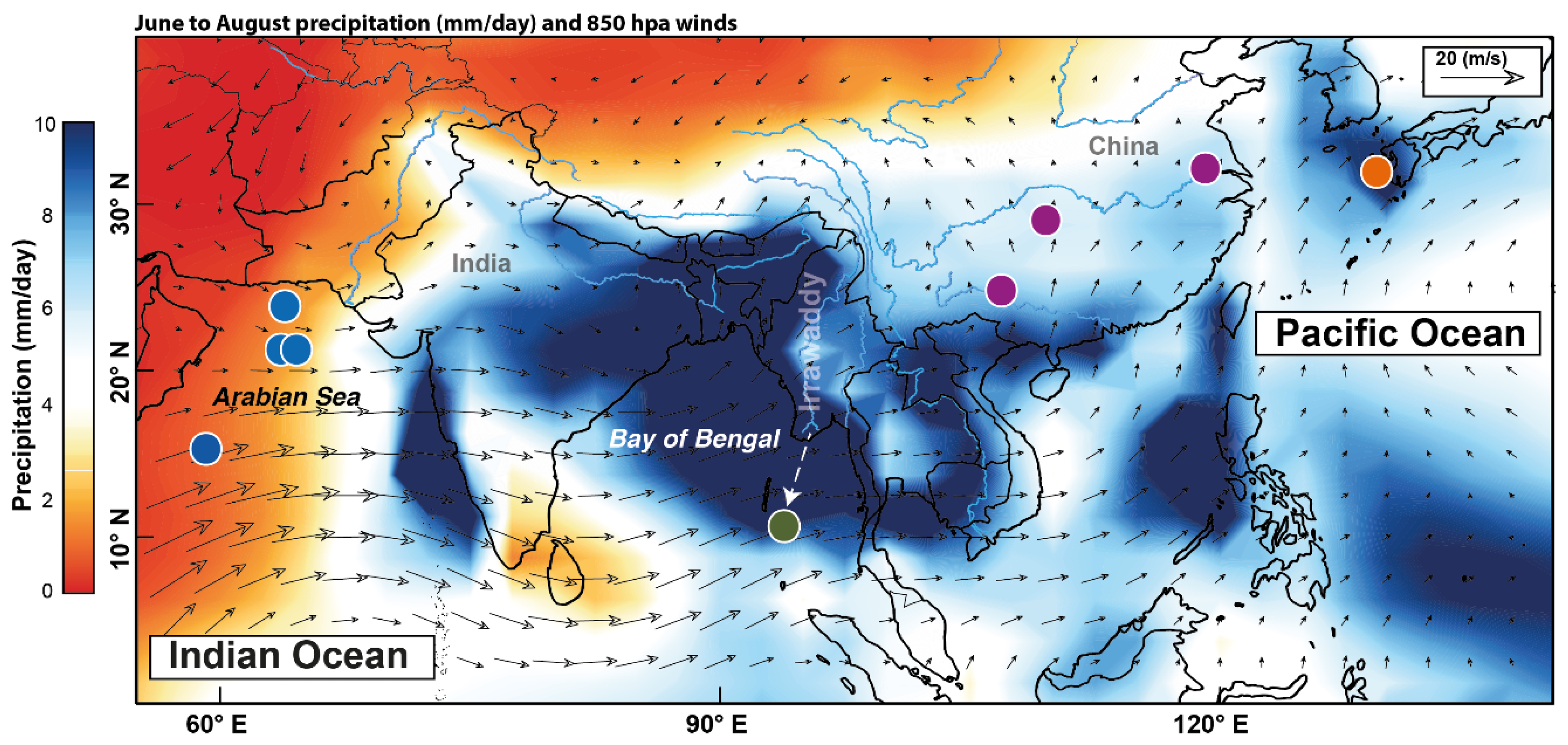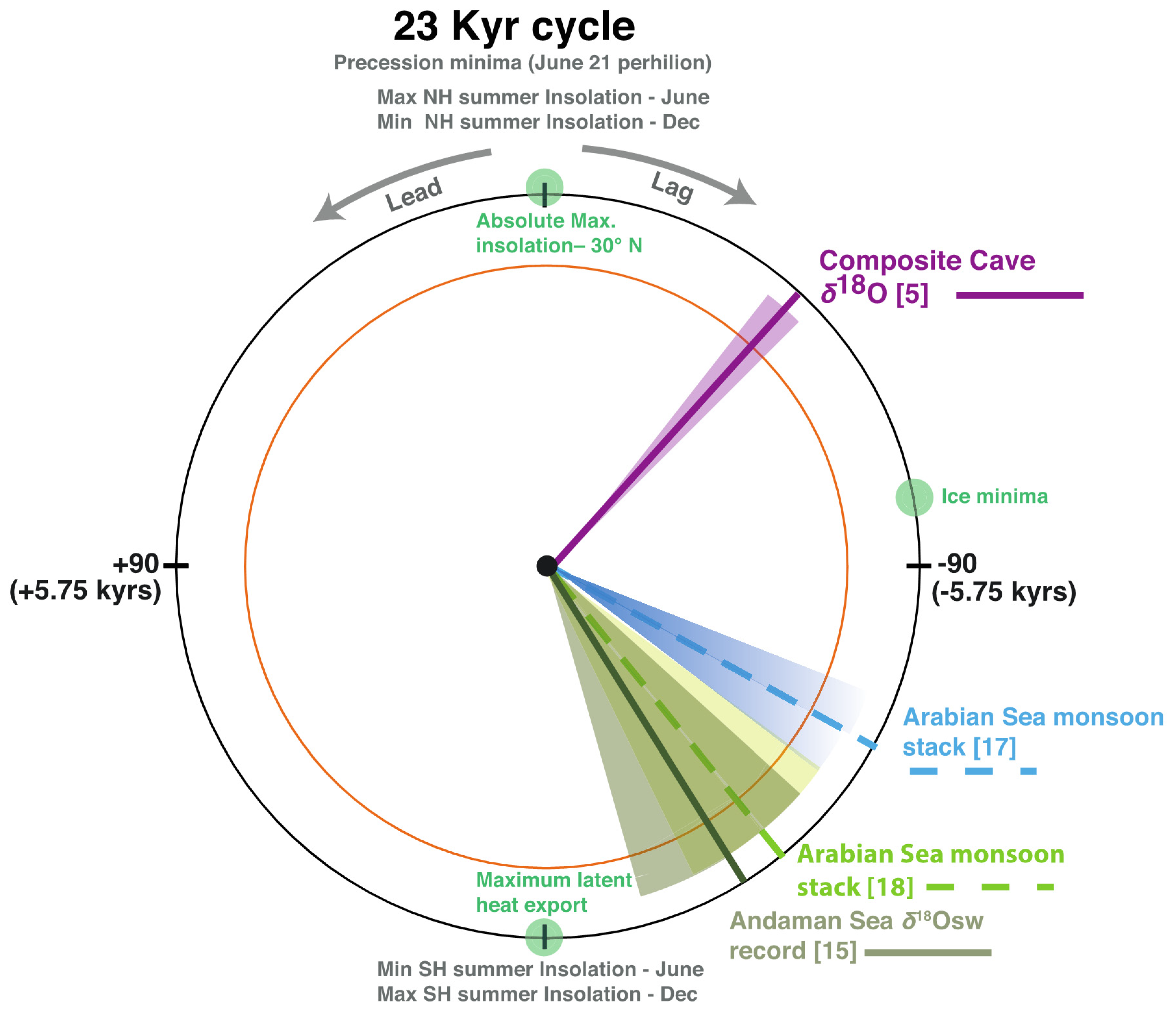A Brief Commentary on the Interpretation of Chinese Speleothem δ18O Records as Summer Monsoon Intensity Tracers
Author Contributions
Funding
Conflicts of Interest
References
- Zhang, H.; Ait Brahim, Y.; Li, H.; Zhao, J.; Kathayat, G.; Tian, Y.; Edwards, R.L. The Asian Summer Monsoon: Teleconnections and Forcing Mechanisms—A Review from Chinese Speleothem δ18O Records. Quaternary 2019, 2, 26. [Google Scholar] [CrossRef]
- Wang, Y.J.; Cheng, H.; Edwards, R.L.; An, Z.S.; Wu, J.Y.; Shen, C.C.; Dorale, J.A. A high-resolution absolute-dated Late Pleistocene monsoon record from Hulu Cave, China. Science 2001, 294, 2345–2348. [Google Scholar] [CrossRef] [PubMed]
- Wang, Y.; Cheng, H.; Edwards, R.L.; Kong, X.; Shao, X.; Chen, S.; An, Z. Millennial- and orbital- scale changes in the East Asian Monsoon over the past 224,000 years. Nature 2008, 451, 1090–1093. [Google Scholar] [CrossRef] [PubMed]
- Cheng, H.; Edwards, R.L.; Broecker, W.S.; Denton, G.H.; Kong, X.; Wang, Y.; Wang, X. Ice age terminations. Science 2009, 326, 248–252. [Google Scholar] [CrossRef] [PubMed]
- Cheng, H.; Edwards, R.L.; Sinha, A.; Spötl, C.; Yi, L.; Chen, S.; Kong, X. The Asian monsoon over the past 640,000 years and ice age terminations. Nature 2016, 534, 640–646. [Google Scholar] [CrossRef] [PubMed]
- Dayem, K.E.; Molnar, P.; Battisti, D.S.; Roe, G.H. Lessons learned from oxygen isotopes in modern precipitation applied to interpretation of speleothem records of paleoclimate from eastern Asia. Earth Planet. Sci. Lett. 2010, 295, 219–230. [Google Scholar] [CrossRef]
- Tan, M. Circulation effect: Response of precipitation δ18O to the ENSO cycle in monsoon regions of China. Clim. Dyn. 2014, 42, 1067–1077. [Google Scholar] [CrossRef]
- Sun, Z.; Yang, Y.; Zhao, J.; Tian, N.; Feng, X. Potential ENSO effects on the oxygen isotope composition of modern speleothems: Observations from Jiguan Cave, central China. J. Hydrol. 2018, 566, 164–174. [Google Scholar] [CrossRef]
- Maher, B.A.; Thompson, R. Oxygen isotopes from Chinese caves: Records not of monsoon rainfall but of circulation regime. J. Quat. Sci. 2012, 27, 615–624. [Google Scholar] [CrossRef]
- Beck, J.W.; Zhou, W.; Li, C.; Wu, Z.; White, L.; Xian, F.; Kong, X.; An, Z. A 550,000-year record of East Asian monsoon rainfall from 10Be in loess. Science 2018, 360, 877–881. [Google Scholar] [CrossRef]
- Liu, Z.; Wen, X.; Brady, E.C.; Otto-Bliesner, B.; Yu, G.; Lu, H.; Edwards, R.L. Chinese cave records and the East Asia summer monsoon. Quat. Sci. Rev. 2014, 83, 115–128. [Google Scholar] [CrossRef]
- Pausata, F.S.; Battisti, D.S.; Nisancioglu, K.H.; Bitz, C.M. Chinese stalagmite δ 18 O controlled by changes in the Indian monsoon during a simulated Heinrich event. Nat. Geosci. 2011, 4, 474. [Google Scholar] [CrossRef]
- Clemens, S.C.; Prell, W.L.; Sun, Y. Orbital-scale timing and mechanisms driving Late Pleistocene Indo-Asian summer monsoons: Reinterpreting cave speleothem δ18O. Paleoceanography 2010, 25. [Google Scholar] [CrossRef]
- Clemens, S.C.; Holbourn, A.; Kubota, Y.; Lee, K.E.; Liu, Z.; Chen, G.; Fox-Kemper, B. Precession-band variance missing from East Asia monsoon runoff. Nat. Commun. 2018, 9, 3364. [Google Scholar] [CrossRef] [PubMed]
- Gebregiorgis, D.; Hathorne, E.C.; Giosan, L.; Clemens, S.; Nürnberg, D.; Frank, M. Southern Hemisphere forcing of South Asian monsoon precipitation over the past~ 1 million years. Nat. Commun. 2018, 9, 4702. [Google Scholar] [CrossRef] [PubMed]
- Clemens, S.C.; Prell, W.; Murray, D.; Shimmield, G.; Weedon, G. Forcing mechanisms of the Indian Ocean monsoon. Nature 1991, 353, 720–725. [Google Scholar] [CrossRef]
- Clemens, S.C.; Prell, W.L. A 350,000 year summer-monsoon multi- proxy stack from the Owen Ridge, Northern Arabian Sea. Mar. Geol. 2003, 201, 35–51. [Google Scholar] [CrossRef]
- Caley, T.; Malaizé, B.; Zaragosi, S.; Rossignol, L.; Bourget, J.; Eynaud, F.; Ellouz-Zimmermann, N. New Arabian Sea records help decipher orbital timing of Indo-Asian monsoon. Earth Planet. Sci. Lett. 2011, 308, 433–444. [Google Scholar] [CrossRef]
- Murtugudde, R.; Seager, R.; Thoppil, P. Arabian Sea response to monsoon variations. Paleoceanography 2007, 22. [Google Scholar] [CrossRef]
- Wang, P.X.; Wang, B.; Cheng, H.; Fasullo, J.; Guo, Z.; Kiefer, T.; Liu, Z. The global monsoon across time scales: Mechanisms and outstanding issues. Earth Sci. Rev. 2017, 174, 84–121. [Google Scholar] [CrossRef]
- Caley, T.; Roche, D.M.; Renssen, H. Orbital Asian summer monsoon dynamics revealed using an isotope-enabled global climate model. Nat. Commun. 2014, 5, 5371. [Google Scholar] [CrossRef] [PubMed]
- Battisti, D.S.; Ding, Q.; Roe, G.H. Coherent pan-Asian climatic and isotopic response to orbital forcing of tropical insolation. J. Geophys. Res. Atmos. 2014, 119, 11–997. [Google Scholar] [CrossRef]
- Prell, W.L.; Kutzbach, J.E. Sensitivity of the Indian monsoon to forcing 104 parameters and implications for its evolution. Nature 1992, 360, 647–652. [Google Scholar] [CrossRef]


© 2020 by the authors. Licensee MDPI, Basel, Switzerland. This article is an open access article distributed under the terms and conditions of the Creative Commons Attribution (CC BY) license (http://creativecommons.org/licenses/by/4.0/).
Share and Cite
Gebregiorgis, D.; Clemens, S.C.; Hathorne, E.C.; Giosan, L.; Thirumalai, K.; Frank, M. A Brief Commentary on the Interpretation of Chinese Speleothem δ18O Records as Summer Monsoon Intensity Tracers. Quaternary 2020, 3, 7. https://doi.org/10.3390/quat3010007
Gebregiorgis D, Clemens SC, Hathorne EC, Giosan L, Thirumalai K, Frank M. A Brief Commentary on the Interpretation of Chinese Speleothem δ18O Records as Summer Monsoon Intensity Tracers. Quaternary. 2020; 3(1):7. https://doi.org/10.3390/quat3010007
Chicago/Turabian StyleGebregiorgis, Daniel, Steven C. Clemens, Ed C. Hathorne, Liviu Giosan, Kaustubh Thirumalai, and Martin Frank. 2020. "A Brief Commentary on the Interpretation of Chinese Speleothem δ18O Records as Summer Monsoon Intensity Tracers" Quaternary 3, no. 1: 7. https://doi.org/10.3390/quat3010007
APA StyleGebregiorgis, D., Clemens, S. C., Hathorne, E. C., Giosan, L., Thirumalai, K., & Frank, M. (2020). A Brief Commentary on the Interpretation of Chinese Speleothem δ18O Records as Summer Monsoon Intensity Tracers. Quaternary, 3(1), 7. https://doi.org/10.3390/quat3010007





